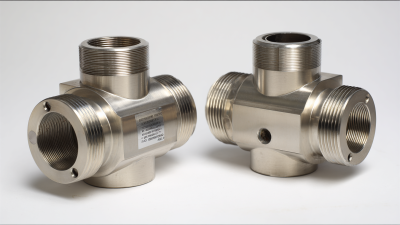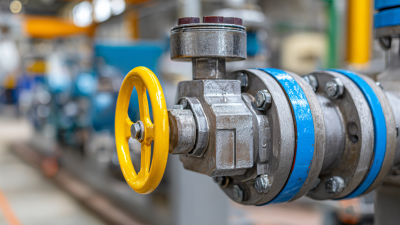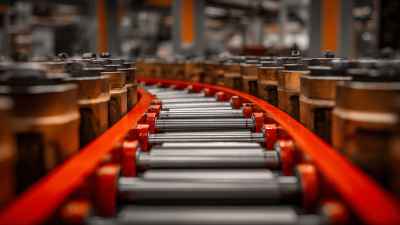
In the realm of industrial applications, the selection of the appropriate wafer check valve plays a crucial role in ensuring optimal fluid management and system efficiency. According to a recent market research report by Mordor Intelligence, the global check valve market is projected to reach USD 8.6 billion by 2025, driven by increasing investments in infrastructure and rising demand for water treatment solutions.

Wafer check valves, known for their compact design and lightweight features, are particularly favored in space-constrained environments, offering significant advantages over traditional valves. With diverse materials and configurations available, understanding the specific operational requirements is essential for making an informed choice. This blog will delve into the key comparison factors to consider when selecting a wafer check valve, ensuring that your industrial applications run smoothly and efficiently.
When selecting the right wafer check valve for industrial applications, understanding key characteristics is crucial for optimal performance. Wafer check valves are designed to provide a compact, lightweight solution for backflow prevention in piping systems. One of the most essential factors to consider is the valve’s material compatibility with the fluid being transported. For instance, whether it’s liquids or gases, materials must resist corrosion and wear to ensure longevity and reliability.
Additionally, the design of the valve plays a significant role in its functionality. Features such as the flow design, pressure ratings, and ease of installation can significantly affect performance and maintenance. A well-implemented wafer check valve minimizes flow resistance, which can help maintain efficiency in a process. Furthermore, ensuring the valve meets specific industry standards can enhance safety and operational effectiveness, making it vital to evaluate the manufacturer's reputation and adherence to quality assurance protocols. Choosing the right wafer check valve is not just about immediate needs; it has long-term implications for system performance and maintenance costs.
When selecting a wafer check valve for industrial applications, the material type plays a crucial role in determining the valve's longevity and performance. The three most prevalent materials used for wafer check valves are stainless steel, cast iron, and PVC. Each material offers distinct advantages that can significantly influence operational efficiency and maintenance needs.
Stainless steel is renowned for its durability and resistance to corrosion, making it ideal for harsh environments and applications involving aggressive fluids. Its longer lifespan can lead to lower replacement costs over time. On the other hand, cast iron valves are often favored for their strength and weight, making them suitable for high-pressure applications. However, users must be cautious of their susceptibility to rust if not properly coated or maintained. Lastly, PVC check valves are lightweight and resistant to a range of chemicals, making them an excellent choice for less demanding environments, but they may not withstand high temperatures or pressures like their metallic counterparts.
Understanding the implications of each material type helps in selecting the right wafer check valve tailored to specific industrial requirements, ultimately maximizing performance and minimizing operational disruptions.
| Material Type | Corrosion Resistance | Temperature Range (°C) | Pressure Rating (PSI) | Typical Application | Longevity (Years) |
|---|---|---|---|---|---|
| Stainless Steel | Excellent | -200 to 550 | 1500 | Chemical Processing | 15-20 |
| Ductile Iron | Good | -20 to 200 | 250 | Water Treatment | 10-15 |
| PVC | Moderate | 0 to 60 | 150 | Drainage Systems | 5-10 |
When selecting a wafer check valve for industrial applications, it's essential to consider where these valves excel compared to other types. One notable application is in the water and wastewater management sector. Wafer check valves are designed to minimize pressure drop and offer quick response times, which are critical for maintaining efficient flow and preventing backflow in treatment plants.
 Another significant application lies in the chemical processing industry. Here, the compact design of wafer check valves allows for easy installation between flanges, making them ideal for space-constrained environments. They also provide excellent sealing capabilities, ensuring minimal leakage, which is vital for handling hazardous materials.
Another significant application lies in the chemical processing industry. Here, the compact design of wafer check valves allows for easy installation between flanges, making them ideal for space-constrained environments. They also provide excellent sealing capabilities, ensuring minimal leakage, which is vital for handling hazardous materials.
Additionally, wafer check valves are increasingly preferred in HVAC systems. Their lightweight construction and ability to handle various temperatures and pressures make them superior choices for maintaining airflow and system integrity. By focusing on these key applications, industrial operators can harness the advantages of wafer check valves to improve efficiency and reliability in their systems.
When selecting a wafer check valve for industrial applications, understanding the impact of proper valve selection on maintenance costs is crucial. Industry data indicates that correct valve choices can lead to a significant reduction in maintenance expenses, with estimates suggesting savings of up to 30%. This is particularly relevant in sectors like glass and vehicle assembly where efficient operations are vital for profitability and productivity.

Tips for ensuring optimal valve selection include assessing the specific application requirements, such as pressure and flow rates, to determine the appropriate valve size and material. Additionally, consider the expected operational environment, including potential exposure to corrosive substances, which can guide the selection process toward the most durable options. Engaging in predictive maintenance practices and utilizing data analytics can further enhance operational efficiency, minimizing unforeseen costs associated with equipment failures.
Moreover, adopting technology advancements such as IoT for continuous monitoring can play a key role in maintaining water quality and overall system health. This proactive stance not only aligns with energy efficiency goals but also supports long-term sustainability within industrial operations.
When selecting a wafer check valve for industrial applications, understanding pressure ratings is crucial. Pressure ratings indicate the maximum pressure at which a valve can operate safely and effectively. Choosing a valve with the appropriate pressure rating can prevent catastrophic failures, prolong equipment life, and ensure the system operates smoothly. Thus, ensuring that the pressure rating matches or exceeds the system's operating conditions is an essential first step in valve selection.
Moreover, pressure ratings can vary significantly among different industries and applications. In high-pressure scenarios, such as oil and gas, selecting a valve with a robust pressure rating ensures reliability under extreme conditions. On the other hand, in water treatment and HVAC applications, moderate pressure ratings might suffice. Evaluating the specific pressure dynamics within your system enables you to choose a valve that not only meets code requirements but also minimizes maintenance costs and downtime. This focused approach allows for a more efficient and reliable industrial operation, ultimately enhancing productivity and safety.





